The Carlsborg Industrial Park provides a space for industrial development within Clallam County’s designated Urban Growth Area. The park is home to many businesses that fall into the category of “low nuisance, low intensity industrial uses,” according to county codes chapter 33.20.
As with any type of zoning, specific codes and county requirements must be met in attempt to lessen the impacts from the Industrial Park on the surrounding residential neighborhoods.
In theory, building and zoning codes may help mitigate effects of the Industrial Park, but in reality, Bryan and Florence Frazier aren’t convinced the county codes are doing much of anything.
“It makes me wonder who’s looking the other way during the inspection process,” Bryan Frazier said.
Impacts
The Fraziers live along East Runnion Road and feel their property and the surrounding properties are being impacted by the park and the lack of code enforcement, Bryan Frazier said.
“All it would take to win most people over around here would be just a little consideration to the surrounding homes,” Florence Frazier said.
The Fraziers admit although they’ve been involved and outspoken with county officials about the Carlsborg Urban Growth Area codes for more than a decade, they have no problem with any of the business owners personally or the park if things like the lighting, visual buffers and points of access were consistent with the county codes.
The Fraziers also question the park’s influence on their property value and claim their property tax assessments reflect the value of their property diminishing, and argue that is partly a result of the neighboring Industrial Park.
“The Carlsborg Industrial Park may affect the value,” said Pamela Rushton, Clallam County assessor. “If it affects the market, it can affect their property.”
Landscaping and buffers
For the casual onlooker passing the Industrial Park along Carlsborg Road the park appears fairly non-descript, however neither of the park’s sides nor the rear are as blended with the surroundings. Along East Runnion Road en route to the Fraziers’ 1940s home a chain link fence is the only thing separating the park from the road and even it has missing sections. A few small trees and short shrubs hug the fence but the visibility into the Industrial Park and the landscaping is seemingly far from county standards.
The codes are fairly specific and include plant standards, screening standards, bulk and dimensional standards, off-street parking and so on.
“New or expanding commercial or industrial land uses within commercial or industrial zones shall provide a 10-foot visual buffer along all street frontages and a 10-foot visual screen along any property line abutting a residential zoning district,” according to code 33.53.030.
If compliant with the county’s codes, the visual buffers along East Runnion Road would be 10 feet in height instead of the current chain link fence with little to no visual buffering.
Lighting
Whether it be parking area lighting, street lighting or security lighting, the codes insist “lighting shall minimize glare, shall be downward facing and/or shielded and shall be directed away from neighboring properties.”
Just down the road from the Fraziers’ property lives Steve Becker and his wife. The couple recently moved to the Carlsborg area in September and were surprised by the amount of light and noise from the park, Becker said. Though Becker acknowledges he was aware he was moving near an industrial zone and therefore anticipated some of the impacts, he didn’t realize county codes were not being enforced to minimize the effects.
“That place (Industrial Park) lights up the whole area at night,” Becker said. “I have a telescope and was looking forward to using it, but realized it doesn’t work very well because of the lighting from the park.”
Enforcement
Despite the county’s codes, which clearly state “commercial/industrial development abutting residential areas shall include a landscape plan that describes tree/shrub species, size of plant materials, and the use of fencing, berms, or solid walls so that noise, light, and aesthetic impacts to residential properties are adequately minimized and/or mitigated,” the Fraziers have been told by county officials the “codes are not enforceable and they (Department of Community Development) don’t have the resources,” Bryan Frazier said.
Kevin LoPiccolo, Community Development planning manager, has visited the home of Bryan and Florence Frazier and acknowledges the buffering and lighting concerns were prevalent and it’s clear there are inconsistencies with the codes, but it turns into a question of how to gain compliance, he said.
“The DCD (Department of Community Development) doesn’t have a code enforcement officer,” LoPiccolo said. “I think it would be beneficial to the community to have an enforcement officer, but it is predicated on available resources.”
Determining the practical amount of code enforcement and how much is too much becomes a factor for county officials when trying to monitor and enforce codes, LoPiccolo said.
“It’s much harder going after something that exists,” LoPiccolo said. “It is more effective to address the concerns with new development.”
How and why the existing businesses were able to build and proceed seemingly out of compliance with some county codes, like lighting for example, LoPiccolo does not have an answer for because he was not present for the construction of the older buildings. But, LoPiccolo assures, county officials have the intention to follow up with the code inconsistency associated with the Industrial Park.
“We want to bring them into compliance,” LoPiccolo said.
Reach Alana Linderoth at alinderoth@sequimgazette.com.


